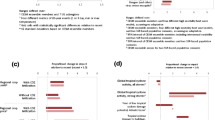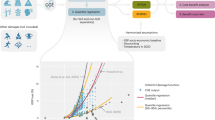Abstract
Purpose
The multiple climate tipping points potential (MCTP) is a novel metric in life-cycle assessment (LCA). It addresses the contribution of greenhouse gas emissions to disturb those processes in the Earth system, which could pass a tipping point and thereby trigger large, abrupt and potentially irreversible changes. The MCTP, however, does not represent ecosystems damage. Here, we further develop this midpoint metric by linking it to losses of terrestrial species biodiversity at either local or global scales.
Method
A mathematical framework was developed to translate midpoint impacts to temperature increase, first, and then to potential loss of species resulting from the temperature increase, using available data on the potentially disappeared fraction of species due to a unit change in global average temperature.
Results and discussion
The resulting damage MCTP expresses the impacts on ecosystems quality in terms of potential loss of terrestrial species resulting from the contribution of GHG emissions to cross climatic tipping points. The MCTP values range from 2.3·10–17 to 1.1·10–15 PDF (potentially disappeared fraction of species) for the global scale and from 2.7·10–17 to 1.1·10–15 PDF per 1 kg of CO2 emitted for the local scale. They are time-dependent, and the largest values are found for emissions occurring between 2030 and 2045, generally declining for emissions occurring toward the end of the century.
Conclusions
The developed metric complements existing damage-level metrics used in LCA, and its application is expected to be especially relevant for products where time-differentiation of emissions is possible. To enable direct comparisons between our damage MCTP and the damage caused by other environmental impacts or other climate-related impact categories, further efforts are needed to harmonize MCTP units with those of the compared damage metrics.




Similar content being viewed by others
Data availability
All data generated during this study are included in this published article [and its supplementary information files].
References
Bjørn A, Owsianiak M, Molin C, Laurent A (2018) Main Characteristics of LCA., in: Hauschild MZ, Rosenbaum RK, Olsen SI (Eds.), Life Cycle Assessment: Theory and Practice. Cham, Eds.; Springer International Publishing: pp. 9–16. https://doi.org/10.1007/978-3-319-56475-3_2
Brodie JF, Aslan CE, Rogers HS, Redford KH, Maron JL, Bronstein JL, Groves CR (2014) Secondary extinctions of biodiversity. Trends Ecol Evol 29:664–672. https://doi.org/10.1016/j.tree.2014.09.012
Cho HS, Moon HS, Kim M, Nam K, Kim JY (2011) Biodegradability and biodegradation rate of poly ( caprolactone ) -starch blend and poly ( butylene succinate ) biodegradable polymer under aerobic and anaerobic environment. Waste Manag 31:475–480. https://doi.org/10.1016/j.wasman.2010.10.029
Curran M, De Baan L, De Schryver AM, Van Zelm R, Hellweg S, Koellner T, Sonnemann G, Huijbregts MAJ (2011) Toward meaningful end points of biodiversity in life cycle assessment. Environ Sci Technol 45:70–79. https://doi.org/10.1021/es101444k
Dunne JA, Williams RJ (2009) Cascading extinctions and community collapse in model food webs. Philos Trans r Soc B Biol Sci 364:1711–1723. https://doi.org/10.1098/rstb.2008.0219
Elith J, Leathwick JR (2009) Species Distribution Models: Ecological Explanation and Prediction Across Space and Time. Annu Rev Ecol Evol Syst 40:677–697. https://doi.org/10.1146/annurev.ecolsys.110308.120159
Fabbri S, Hauschild MZ, Lenton TM, Owsianiak M (2021) Multiple climate tipping points metrics for improved sustainability assessment of products and services. Environ Sci Technol 55:2800–2810. https://doi.org/10.1021/acs.est.0c02928
Goedkoop M, Heijungs R, Huijbregts M, De Schryver A, Struijs J, Van Zelm R (2009) ReCiPe 2008 -A life cycle impact assessment method which comprises harmonised category indicators at the midpoint and the endpoint level. Report 1: Characterization
Hauschild MZ, Huijbregts MAJ (2015) Life Cycle Impact Assessment, in: Klopffer W, Curran MA (Eds.), LCA Compendium – The Complete World of Life Cycle Assessment, Springer
Huijbregts MAJ, Steinmann ZJN, Elshout PMF, Stam G, Verones F, Vieira M, Zijp M, Hollander A, van Zelm R (2017) ReCiPe2016: a harmonised life cycle impact assessment method at midpoint and endpoint level. Int J Life Cycle Assess 22:138–147. https://doi.org/10.1007/s11367-016-1246-y
Ishigaki T, Sugano W, Nakanishi A, Tateda M, Ike M, Fujita M (2004) The degradability of biodegradable plastics in aerobic and anaerobic waste landfill model reactors. Chemosphere 54:225–233. https://doi.org/10.1016/S0045-6535(03)00750-1
Jolliet O, Antón A, Boulay A, Cherubini F, Fantke P, Levasseur A, Mckone TE, Michelsen O, Milà L, Motoshita M (2018) Global guidance on environmental life cycle impact assessment indicators : impacts of climate change, fine particulate matter formation, water consumption and land use. Int J Life Cycle Assess 23:2189–2207
Jørgensen SV, Hauschild MZ, Nielsen PH (2015) The potential contribution to climate change mitigation from temporary carbon storage in biomaterials. Int J Life Cycle Assess 20:451–462. https://doi.org/10.1007/s11367-015-0845-3
Jørgensen SV, Hauschild MZ, Nielsen PH (2014) Assessment of urgent impacts of greenhouse gas emissions - The climate tipping potential (CTP). Int J Life Cycle Assess 19:919–930. https://doi.org/10.1007/s11367-013-0693-y
Lenton TM, Held H, Kriegler E, Hall JW, Lucht W, Rahmstorf S, Schellnhuber HJ (2008) Tipping elements in the Earth’s climate system. Proc Natl Acad Sci 105:1786–1793. https://doi.org/10.1073/pnas.0705414105
Meinshausen M, Smith SJ, Calvin K, Daniel JS, Kainuma MLT, Lamarque J, Matsumoto K, Montzka SA, Raper SCB, Riahi K, Thomson A, Velders GJM, van Vuuren DPP (2011) The RCP greenhouse gas concentrations and their extensions from 1765 to 2300. Clim Change 109:213–241. https://doi.org/10.1007/s10584-011-0156-z
Millar JR, Nicholls ZR, Friedlingstein P, Allen MR (2017) A modified impulse-response representation of the global near-surface air temperature and atmospheric concentration response to carbon dioxide emissions. Atmos Chem Phys 17:7213–7228. https://doi.org/10.5194/acp-17-7213-2017
Mora C, Tittensor DP, Adl S, Simpson AGB, Worm B (2011) How many species are there on earth and in the ocean? PLoS Biol 9:1–8. https://doi.org/10.1371/journal.pbio.1001127
Newbold T (2018) Future effects of climate and land-use change on terrestrial vertebrate community diversity under different scenarios. Proc R Soc B Biol Sci 285. https://doi.org/10.1098/rspb.2018.0792
Pearson RG, Dawson TP (2003) Predicting the impacts of climate change on the distribution of species: Are bioclimate envelope models useful? Glob Ecol Biogeogr 12:361–371. https://doi.org/10.1046/j.1466-822X.2003.00042.x
Post E, Forchhammer MC, Bret-Harte MS, Callaghan TV, Christensen TR, Elberling B, Fox AD, Gilg O, Hik DS, Høye TT, Ims RA, Jeppesen E, Klein DR, Madsen J, McGuire AD, Rysgaard S, Schindler DE, Stirling I, Tamstorf MP, Tyler NJC, Van Der Wal R, Welker J, Wookey PA, Schmidt NM, Aastrup P (2009) Ecological dynamics across the arctic associated with recent climate change. Science 325(80):1355–1358. https://doi.org/10.1126/science.1173113
Purvis A (2020) A single apex target for biodiversity would be bad news for both nature and people. Nat Ecol Evol 4:768–769. https://doi.org/10.1038/s41559-020-1181-y
Rossi V, Cleeve-Edwards N, Lundquist L, Schenker U, Dubois C, Humbert S, Jolliet O (2015) Life cycle assessment of end-of-life options for two biodegradable packaging materials: Sound application of the European waste hierarchy. J Clean Prod 86:132–145. https://doi.org/10.1016/j.jclepro.2014.08.049
Sanford T, Frumhoff PC, Luers A, Gulledge J (2014) The climate policy narrative for a dangerously warming world. Nat Clim Chang 4:164–166. https://doi.org/10.1038/nclimate2148
Steffen W, Rockström J, Richardson K, Lenton TM, Folke C, Liverman D, Summerhayes CP, Barnosky AD, Cornell SE, Crucifix M, Donges JF, Fetzer I, Lade SJ, Scheffer M, Winkelmann R, Schellnhuber HJ (2018) Trajectories of the Earth System in the Anthropocene. Proc Natl Acad Sci 115:8252–8259. https://doi.org/10.1073/pnas.1810141115
Tansel B (2019) Persistence times of refractory materials in landfills: A review of rate limiting conditions by mass transfer and reaction kinetics. J Environ Manage 247:88–103. https://doi.org/10.1016/j.jenvman.2019.06.056
Thuiller W, Münkemüller T, Lavergne S, Mouillot D, Mouquet N, Schiffers K, Gravel D (2013) A road map for integrating eco-evolutionary processes into biodiversity models. Ecol Lett 16:94–105. https://doi.org/10.1111/ele.12104
Urban MC (2015) Accelerating extinction risk from climate change. Science 348(80):571–573. https://doi.org/10.1126/science.aaa4984
van Vliet J, den Elzen MGJ, van Vuuren DP (2009) Meeting radiative forcing targets under delayed participation. Energy Econ 31:S152–S162. https://doi.org/10.1016/j.eneco.2009.06.010
van Vuuren DP, Edmonds J, Kainuma M, Riahi K, Thomson A, Hibbard K, Hurtt GC, Kram T, Krey V, Lamarque J-F, Masui T, Meinshausen M, Nakicenovic N, Smith SJ, Rose SK (2011) The representative concentration pathways: an overview. Clim Change 109:5–31. https://doi.org/10.1007/s10584-011-0148-z
Verones F, Hellweg S, Antón A, Azevedo LB, Chaudhary A, Cosme N, Cucurachi S, de Baan L, Dong Y, Fantke P, Golsteijn L, Hauschild M, Heijungs R, Jolliet O, Juraske R, Larsen H, Laurent A, Mutel CL, Margni M, Núñez M, Owsianiak M, Pfister S, Ponsioen T, Preiss P, Rosenbaum RK, Roy PO, Sala S, Steinmann Z, van Zelm R, Van Dingenen R, Vieira M, Huijbregts MAJ (2020) LC-IMPACT: A regionalized life cycle damage assessment method. J Ind Ecol 1:19. https://doi.org/10.1111/jiec.13018
Verones F, Huijbregts MAJ, Azevedo LB, Chaudhary A, Baan L, De Fantke P, Hauschild M, Henderson AD, Mutel CL, Owsianiak M, Pfister S, Preiss P, Roy O, Scherer L, Steinmann Z, Van Zelm R, Van Dingenen R (2019) LC-IMPACT Version 1.0 - A spatially differentiated life cycle impact assessment approach [WWW Document]. https://lc-impact.eu/. (Accessed 9 Aug 2020)
Woods JS, Damiani M, Fantke P, Henderson AD, Johnston JM, Bare J, Sala S, Maia de Souza D, Pfister S, Posthuma L, Rosenbaum RK, Verones F (2018) Ecosystem quality in LCIA: status quo, harmonization, and suggestions for the way forward. Int J Life Cycle Assess 23:1995–2006. https://doi.org/10.1007/s11367-017-1422-8
Acknowledgements
We thank the European Commission Horizon 2020 project H2020-BBI-JTI-2016: BioBarr, grant agreement 745586 for the financial support during the development of this work.
Funding
This work was financially supported by the European Commission under Horizon 2020; H2020-BBI-JTI-2016: BioBarr, grant agreement 745586.
Author information
Authors and Affiliations
Corresponding author
Ethics declarations
Conflict of interest
The authors have no competing interests to declare.
Additional information
Communicated by Masaharu Motoshita.
Publisher's Note
Springer Nature remains neutral with regard to jurisdictional claims in published maps and institutional affiliations.
Supplementary Information
Below is the link to the electronic supplementary material.
Rights and permissions
Springer Nature or its licensor holds exclusive rights to this article under a publishing agreement with the author(s) or other rightsholder(s); author self-archiving of the accepted manuscript version of this article is solely governed by the terms of such publishing agreement and applicable law.
About this article
Cite this article
Fabbri, S., Owsianiak, M., Newbold, T. et al. Development of climate tipping damage metric for life-cycle assessment—the influence of increased warming from the tipping. Int J Life Cycle Assess 27, 1199–1212 (2022). https://doi.org/10.1007/s11367-022-02096-z
Received:
Accepted:
Published:
Issue Date:
DOI: https://doi.org/10.1007/s11367-022-02096-z




